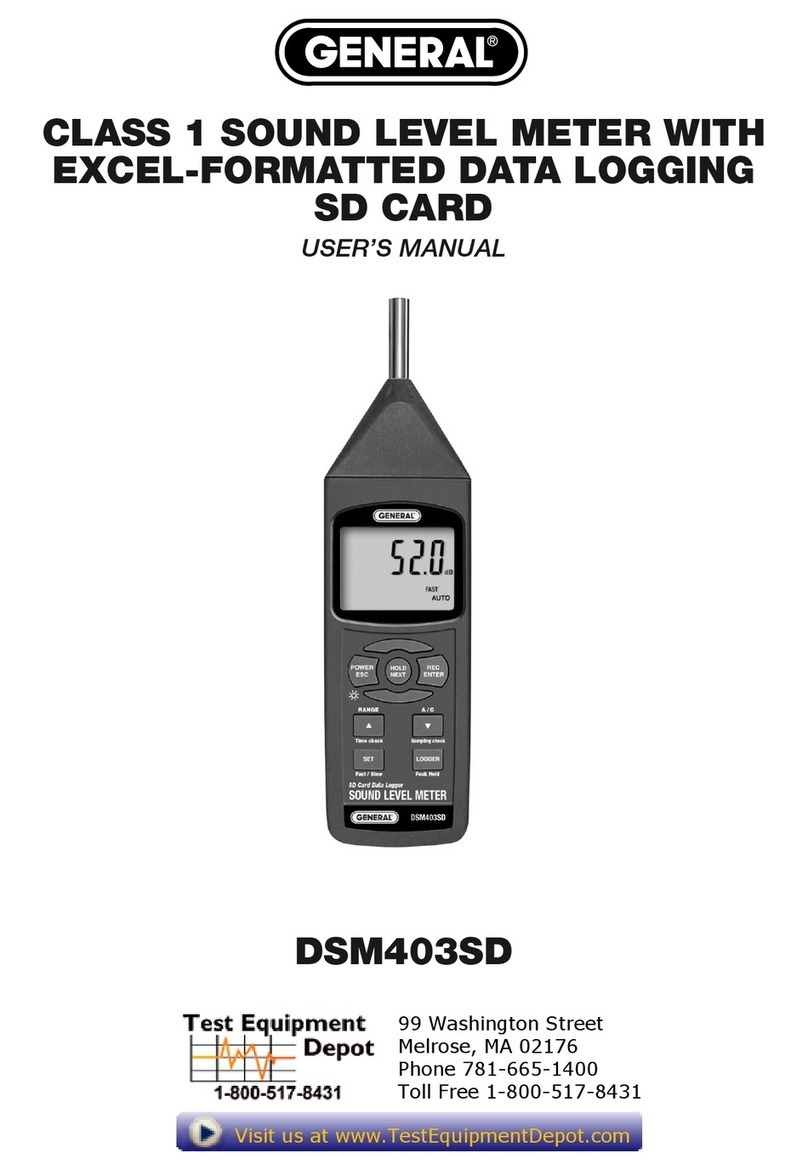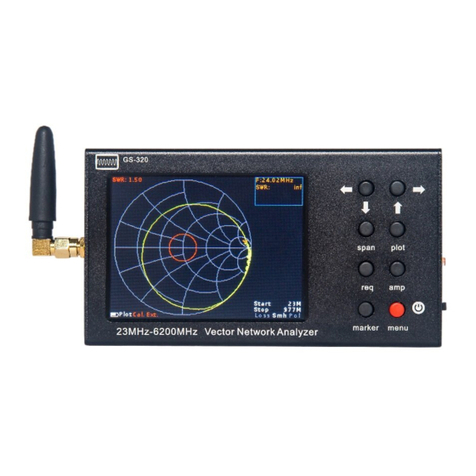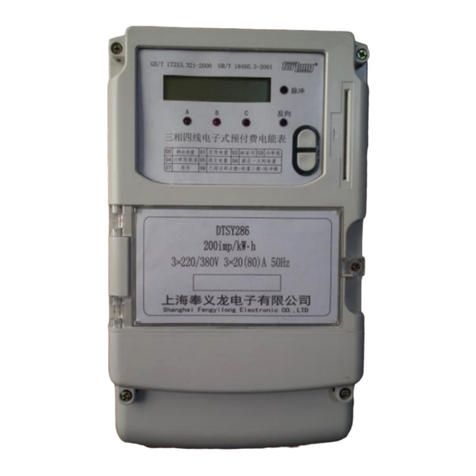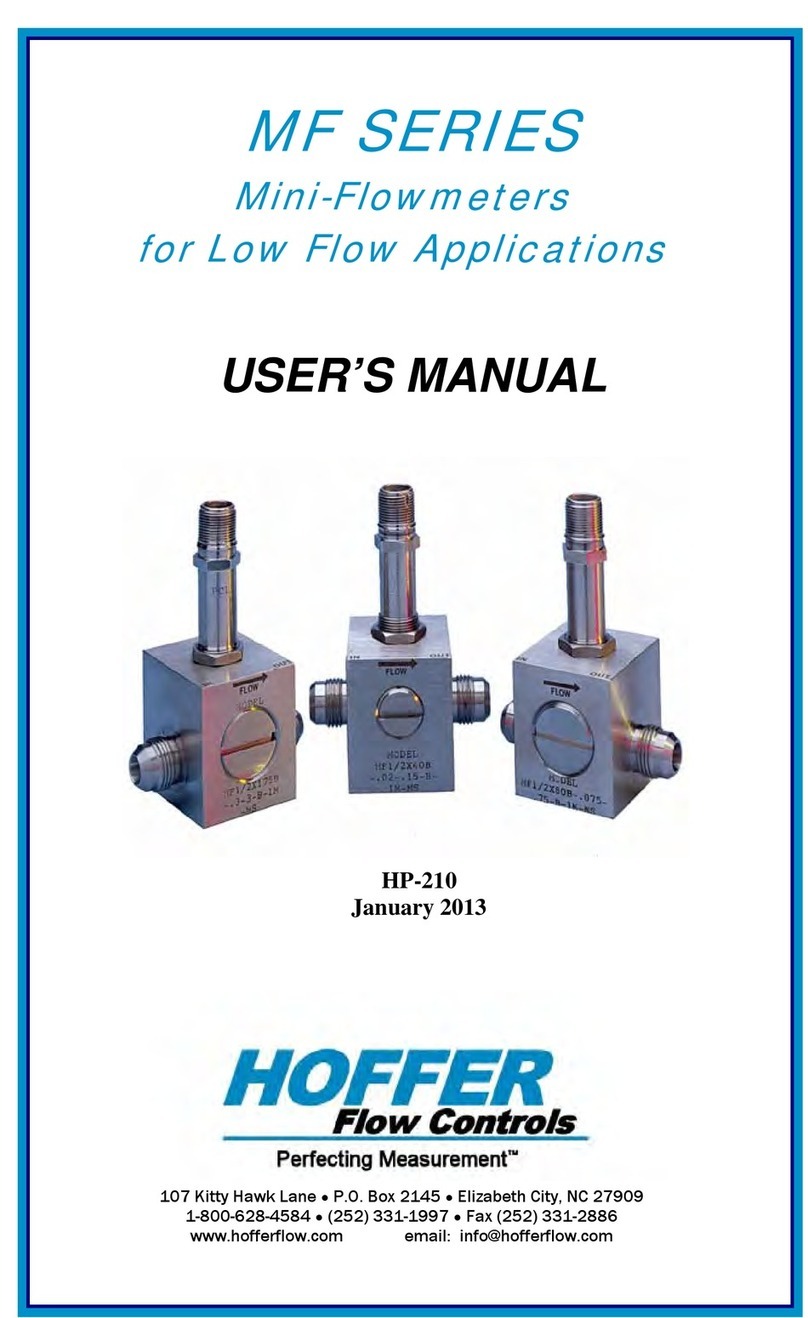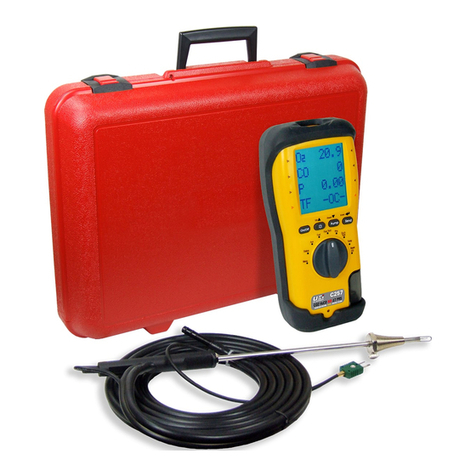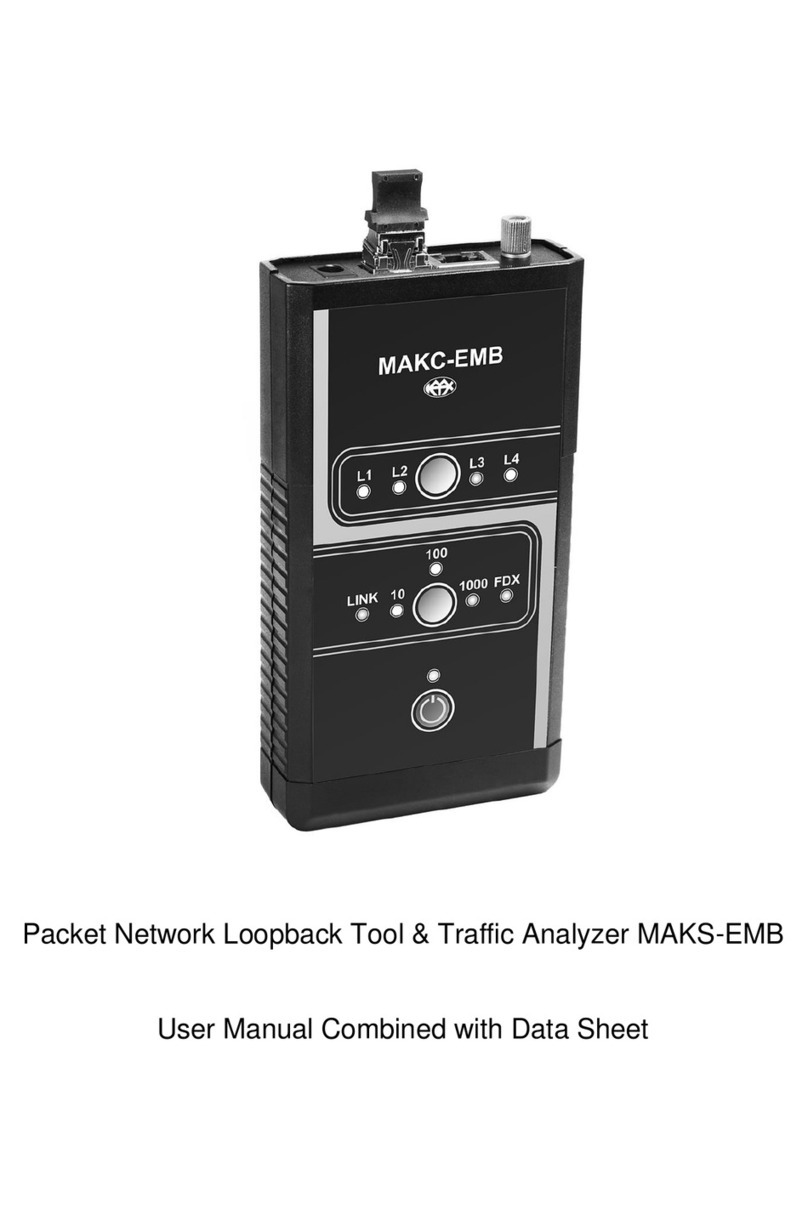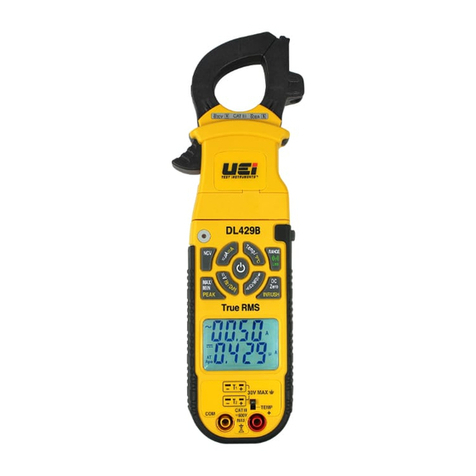Miltenyi Biotec MACSQuant Series User manual

MACSQuant® Instrument
User manual

Copyright © 2019 Miltenyi Biotec GmbH and/or its affiliates. All rights reserved.
No part of this user manual may be reproduced, stored in a retrieval system, transmitted, published, or distributed in any form or by any means,
electronically, mechanically, by photocopying, microfilming, recording, or otherwise, without the prior written consent of Miltenyi Biotec; however,
notwithstanding the foregoing, the owners of the MACSQuant® Instrument may make copies solely for purposes of training personnel in the use and
servicing of the unit within their business or organization. Maximal care has been taken by Miltenyi Biotec in the preparation of this user manual. However,
Miltenyi Biotec shall not be liable for any technical or editorial errors or omissions contained herein or for incidental or consequential damages in
connection with the furnishing, performance, or use of this document. The information in this document is provided “as is” without warranty of any kind,
and is subject to change without notice. MACS, the MACS logo, MACSQuant and MACSQuantifyare either registered trademarks or trademarks of Miltenyi
Biotec and/or its affiliates in various countries worldwide. All other trademarks mentioned in this document are the property of their respective owners
and are used for identification purposes only. Unless otherwise specifically indicated, Miltenyi Biotec products and services are for research use only and
not for therapeutic or diagnostic use.

MACSQuant® Instrument
User manual
Original instructions
Miltenyi Biotec GmbH
Friedrich-Ebert-Straße 68
51429 Bergisch Gladbach
Germany
Phone +49 2204 8306-0
Fax +49 2204 85197
macs@miltenyibiotec.de
www.miltenyibiotec.com

Read the user manual before using the instrument
Before using the MACSQuant® Instrument (MACSQuant Analyzer 10, VYB, or Analyzer 16), read the chapter
Important safety information and all other information contained in this user manual, including any safety
and operating instructions. Pay special attention to all warnings displayed on the instrument. Failure to read and
follow these guidelines could lead to improper or incorrect usage and result in damage to the instrument.
Improper usage could also cause severe personal injury, death, unpredictable results, instrument malfunction,
and premature wear to components shortening the lifetime of the instrument. Such actions may void your
warranty. Keep the user manual and any other safety and operating instructions provided with the instrument in
a safe place accessible to all users for future reference.
If you have a serious concern regarding the safe use of your instrument, please contact your authorized Miltenyi
Biotec service provider or call Miltenyi Biotec Technical Support.
2

Content
Important safety information 7
Wichtige Sicherheitshinweise 17
Información importante de seguridad 27
Informations de sécurité importantes 37
Importanti istruzioni di sicurezza 47
1 Introduction 57
1.1 Intended use 57
1.2 Key features of the MACSQuant® Instrument 57
2 Installation 61
2.1 Components included in the delivery 61
2.2 Consumables 62
2.3 Accessories 62
2.4 Service contracts 62
2.5 Assembly 63
2.5.1 Install the fluid bottles 63
2.5.2 Install the Single tube rack 65
2.5.3 Connect the instrument to the power supply 65
2.5.4 Installation of the MACSQuant® Column 66
2.5.5 Install the webcam 67
2.5.6 Install the needle guard 68
2.5.7 Install the MACS® MiniSampler Plus 69
2.5.8 Install the Chill Rack and Universal Reagent Rack 71
2.5.9 Installation checklist 73
3 Operating the instrument 75
3.1 Switching on the instrument 75
3.2 Shutting down 75
3.2.1 Manual shutdown 75
3.2.2 Automatic shutdown 75
3

3.3 Long-term storage 76
4 Calibration 77
4.1 Calibrating the sample uptake unit 77
4.1.1 Calibrating the robotic needle arm 77
4.1.2 Calibration of the Single tube rack 79
4.1.3 Calibration of the Chill 5 Rack 79
4.1.4 Calibration of the 96-well plate 79
4.1.5 Calibration of the MACSPlex Filter Plate 80
4.1.6 Calibration of MACS® Reagent Rack 4 80
4.1.7 Calibration of Universal Reagent Rack 81
4.1.8 Calibration of custom 96 racks 81
4.2 Calibrating the rack detection 81
4.2.1 Single tube rack detection 81
4.2.2 Rack detection 82
5 Hardware monitor 85
5.1 Hardware monitor 85
5.1.1 Fluidics 85
5.1.2 Sample uptake unit 86
5.1.3 Lasers and detectors 86
5.2 Instrument status LEDs 87
6 Live Support 89
7 Maintenance 91
7.1 Decontaminating the instrument 91
7.2 Exchanging fluid bottles 91
7.3 Exchanging the MACSQuant® Column 91
7.4 Exchanging hydrophobic air filters 92
7.5 Long-term storage of the instrument 92
7.6 Cleaning programs 92
8 Troubleshooting 93
4

8.1 Column leakage 93
8.2 Syringe pump leakage 93
8.3 Air bubbles during measurement / no event acquisition 93
8.4 Excessive debris is present during acquisition 93
8.5 Touchscreen remains dark 94
9 Technical data and specifications 95
9.1 EC Declaration of conformity (MACSQuant Analyzer 10) 99
9.1.1 Additional international conformity (MACSQuant Analyzer 10) 100
9.2 EC Declaration of conformity (MACSQuant VYB) 100
9.2.1 Additional international conformity (MACSQuant VYB) 100
9.3 EC Declaration of conformity (MACSQuant Analyzer 16) 101
9.3.1 Additional international conformity (MACSQuant Analyzer 16) 101
9.4 Technical data and specifications of the MACS MiniSampler Plus 101
10 Technical support 103
11 Limited warranty 105
12 Index 107
5

6

EN
Important safety information
Warnings and precautions
The instrument is designed for safe use when installed correctly, operated by trained personnel, operated in
accordance with general safety practices and the instructions in this user manual.
The guidelines in this section explain the potential risk associated with operating this instrument and provide
important supplemental safety information to minimize the risks. Follow the instructions carefully to protect
yourself, others, and the equipment from potential hazards and create a safe work environment. Use this
instrument only as specified by the manufacturer to avoid damage of equipment and injury to personnel.
Always follow local working area safety instructions and laboratory policies as well as standards for health,
safety and prevention of accidents. Contact the local authorities governing electrical power supply, building
constructions, maintenance, or safety for more information about the safe installation and operation of the
instrument.
Hazard levels
Signal words are used to identify safety and property damage messages. The following signal words are used
throughout this user manual.
or WARNING! indicates a potentially hazardous situation, which, if not avoided, could result in death or serious
injury.
or CAUTION! indicates a potentially hazardous situation, which, if not avoided, may result in minor or
moderate injury. It may also be used to alert against unsafe practices.
7
IMPORTANT SAFETY INFORMATION
EN
DEESFRIT

Safety symbols
The following symbols are used to highlight conditions that could cause injury to personnel.
Safety alert. Risk of danger. The documentation needs to be consulted in all cases where this safety alert
symbol is used on the instrument, in order to find out the nature of the potential hazard and any actions that
have to be taken.
Risk of electric shock.
Strong magnetic field.
Persons carrying a pacemaker or other electronic implants must maintain distance.
Risk of crushing and shearing of bodily parts.
Hazardous optical radiation.
Hazardous laser radiation.
Biohazard. Risk of contamination if potentially dangerous biological material is used.
Protective conductor terminal. Symbol is attached on the inside of the instrument. Information for service
personnel.
On (Power supply).
Off (Power supply).
IMPORTANT SAFETY INFORMATION
EN
DEESFRIT
8

Safety labels
Note the hazard points and safety symbols of the instrument. All safety labels and safety markings must be kept
clean and legible. Inspect the safety labels and safety markings regularly and replace them if not legible or
identifiable from a safe viewing distance. Contact Miltenyi Biotec for replacement labels.
Safety labels on the instrument
Figure 1: Hazard areas and safety symbols on the front of the MACSQuant® Instrument.
9
IMPORTANT SAFETY INFORMATION
EN
DEESFRIT

Figure 2: Hazard areas and safety symbols on the rear side of the MACSQuant® Instrument.
General safety instructions
Safe operation of the instrument is no longer ensured if the instrument is not working properly and/or the
displayed instructions or messages advise you to contact Technical Support. Immediately switch off and unplug
the instrument from the power outlet and contact an authorized Miltenyi Biotec service provider or Miltenyi
Biotec Technical Support.
Electricity and fire hazards
Potential risks arising from electrical devices include electric shock, short, and overheating. Electric shock may
lead to severe personal injury or death.
An electric short and overheating may lead to the spread of fire. Electronic equipment might emit sparks, which
could ignite combustible vapors or material resulting in explosion or fire.
Do not use the instrument in areas classified as hazardous locations; for example, in oxygen-
laden environments. If flames or smoke appear, immediately switch off the power supply,
unplug the instrument from the electrical outlet, and contact an authorized Miltenyi Biotec
service provider or Miltenyi Biotec Technical Support.
IMPORTANT SAFETY INFORMATION
EN
DEESFRIT
10

The instrument housing is designed to lower the risk of electric shock, short, and spread of fire. Except for the
front access covers, do not remove or penetrate any cover, nor any cover of other accessory
hardware supplied by Miltenyi Biotec. Only authorized personnel is allowed to remove any
other cover of the instrument. Never push an foreign object through an opening into the
instrument.
Do not use the instrument if
lit has been opened or disassembled
lit has been dropped or damaged
lit has damaged or broken parts
lit has a damaged power cable
lan object has entered through the ventilation slots
lan object has been dropped into the instrument
The instrument is intended for indoor use only. If liquids enter the instrument, it may lead to electric shorts,
shock, or fire. Take special care while handling liquids.
Do not allow liquids to enter the interior of the instrument. Protect the instrument against
accidental spillages and splashes. Clean up spillages immediately. Do not operate the
instrument if liquids have entered the instrument. Do not use the instrument in a wet and damp
location. Avoid areas with high humidity or condensation. Moving the instrument from a cold environment –
such as a cold room at 5°C – to room temperature may cause condensation inside the instrument. In such
cases, wait for the instrument to dehumidify before operating it.
Before cleaning, unplug the instrument. Do not use liquid or aerosol cleaning agents, always use a damp cloth.
Protect the instrument from overheating. Do not use the instrument in areas with more than 25°C. Ensure
adequate air circulation in the room when the instrument is operated. Allow sufficient air circulation around the
instrument – at least 15 cm on all sides – during operation. Do not place the instrument near radiators,
heat registers, stoves, or other equipment (including amplifiers) that generate heat. Protect the
instrument from direct sunlight. Do not cover the slots and openings of the instrument as
these are provided for ventilation. Do not place the instrument in a built-in rack or similar confined
spaces unless the space has been specifically designed to provide proper ventilation. Follow the mounting
instructions for the instrument.
The instrument is equipped with a three-wire electrical grounding-type plug that has a third pin for grounding.
This plug fits in a grounded power outlet only. This is a safety feature. Do not try to insert the plug into a
non-grounded power outlet. If you cannot insert the plug into the outlet, contact your local electrician to
replace the outlet.
Only peripheral devices that comply to UL 60950 are allowed to be connected to the RS232 connector labeled
COM1.Only original MACSQuant Instrument equipment should be attached to the connectors labeled External
CAN.
Only the 2D code reader that was delivered with the instrument should be connected to to the RS232/BCR port.
External laser devices connected to to the RS232/BCR port have to comply with the standard IEC 60825-1.
11
IMPORTANT SAFETY INFORMATION
EN
DEESFRIT

In order to ensure electromagnetic compliance, connect peripheral devices only with double-shielded cables
and only use the power cable and the keypad included in delivery. Only use connector cables less than 3 m in
length. Use the keypad with MACSQuant® Instrument models only.
Ensure that the main switch as well as the plug of the power cable are easily accessible and located as close to
the operator of the instrument as possible. If it is necessary to disconnect the power supply, unplug the cable
from the power outlet.
The instrument should only be operated from a power source that meets the specifications mentioned on the
product´s electrical ratings label. If you have questions about the type of power source to use, contact your
authorized Miltenyi Biotec service provider or local power company.
Do not use extension cords or power strips. Do not overload an electrical outlet.
Strong magnetic field
The instrument is equipped with an extremely powerful magnet. There is a risk of severe personal injury for
persons carrying pacemakers, brain shunts or electronic medical implants.
Persons carrying pacemakers or electronic medical implants must maintain distance. Keep all
magnetic storage devices, electronic equipment and magnetizable objects at a distance of at least 20 cm.
Mechanical hazards
Moving and revolving parts are potential mechanical hazards.
Do not open the front access covers while the instrument is in operation. Do not obstruct the
movement of the robotic needle arm and accessory hardware during operation. There is a risk
of puncturing, crushing and shearing bodily parts. Keep fingers etc. away from all moving parts
of the instrument or accessory hardware. Do not circumvent any safety measures or devices.
Do not touch fluid pumps or adjust the tubing while the instrument is in operation. Always switch off the
instrument before adjusting any part of the fluidic system. Always stop or abort a procedure before handling
accessory hardware, e.g., MACS MiniSampler Plus, or loading/removing tubes from the tube rack. Operate only
with attached needle guard.
Optical radiation hazards
The MACSQuant® Instrument is classified as a Class 1 Mlaser product per standard IEC 60825-1:2014. The
MACSQuant Instrument is equipped with three Continous-Wave Lasers (laser class 3B). These lasers are secured
by a protective housing. Do not remove the protective housing. Use of controls or adjustments or
performance of procedures other than those specified herein may result in hazardous radiation
exposure.
The instrument is equipped with four vertical cavity surface emitting lasers (VCSEL) for automated rack
detection (Class 1M). The radiation is not visible.
Invisible laser radiation. Do not expose users of telescopic optics.
Do not look at the VCSEL port through optical instruments such as magnifying glasses. Looking
at the VCSEL port from a distance less than 100 mm may damage the eyes.
IMPORTANT SAFETY INFORMATION
EN
DEESFRIT
12

The instrument is equipped with a 2D Code Reader with powerful light emitting diodes (LEDs) for illuminating
the reading area. Powerful LEDs are also used to illuminate the fluid bottles as well as the waste bottle.
According to the international standard IEC 62471, this lamp system has an exposure hazard value (EHV) of
0.91 and is in excess of the Exempt Risk Group.
Do not remove the protective housing.
Do not remove the bottle holders unless integrating the instrument into a liquid handling
system. If the bottle holders are removed, make sure users are not exposed to emitted LED
radiation.
Do not look directly at laser or LED radiation or reflected laser or LED radiation from a mirrored
surface. Otherwise, eye injury may result. Do not direct the laser beam at others.
Be careful of the path of the light beam or reflection from a mirrored surface. Take care during installation of
the instrument that the path of the light beam is not at the same height as the human eye during operation. Do
not allow water, oil, dust or other foreign substances to stick to the 2D Code Reader aperture window. This may
cause reading errors. Be sure to stop the laser emission before cleaning the scanner. Otherwise, exposure to the
light may cause eye injury. Use a soft, dry cloth to wipe any substances from the scanner. Do not use alcohol or
other cleaning substances.
Radiation of disassembled units may lead to eye injuries. Do not disassemble, modify, or remove the
installed laser or LED radiation sources. The laser or LED radiation sources do not automatically
stop emitting when disassembled.
The hazard distance (HD) for the Exempt Risk group is 61 cm. The hazard distance for Risk group 1 is 20 cm.
Output power Pulse time Wavelength
MACSQuant Analyzer 10
Rack Detection 3.3 mW 215 μs 850 nm
Internal Laser 1 30 mW Continuous 488 nm
Internal Laser 2 21.5 mW Continuous 404 nm
Internal Laser 3 40 mW Continuous 640 nm
MACSQuant VYB
Rack Detection 3.3 mW 215 μs 850 nm
Internal Laser 1 50 mW Continuous 488 nm
Internal Laser 2 40 mW Continuous 404 nm
Internal Laser 3 100 mW Continuous 561 nm
MACSQuant Analyzer 16
Rack Detection 3.3 mW 215 μs 850 nm
Internal Laser 1 50 mW Continuous 488 nm
Internal Laser 2 65 mW Continuous 404 nm
Internal Laser 3 72 mW Continuous 642 nm
Table 2.1: Laser output power, pulse time, and wavelength.
13
IMPORTANT SAFETY INFORMATION
EN
DEESFRIT

Chemical and biological hazards
Depending on the biological material used, contamination infection may lead to severe personal injury or
death. All clinical samples must be considered potentially infectious.
If biohazardous material is or has been used, the operator must choose and wear personal
safety equipment as indicated in the warnings and precautions for the particular substance.
The above safety precaution also accounts for any hazardous chemical, including toxic or
corrosive chemicals, acidic or radioactive substances that may be present in the sample.
Wear protective gloves and clothing, as well as safety glasses to prevent contact of the substance with skin and
eyes. Defective or inadequate safety equipment is hazardous. If hazardous material has been used or spilled,
care must be taken to thoroughly decontaminate the instrument. It is strictly prohibited to continue to handle
contaminated accessories or parts of the instrument.
Also protect mouth and nose as aerosols might leak from the system. The instrument must be operated in a
safety hood if hazardous or unknown material is being processed.
All liquid and solid waste must be considered hazardous and, must be therefore handled taking universal
laboratory precautions. Waste disposal must be in accordance with any local regulations.
Before disposal, decontaminate all tubes and other consumables that were in contact with
biohazardous material. Liquid waste must be autoclaved or decontaminated using a disinfectant that is
appropriate for the specific pathogen, e.g., 10% bleach, isopropyl alcohol, or 70% ethanol.
Failure of parts containing biohazardous material or liquids that have been in contact with such materials could
cause a hazard.
Always inspect the fluidics system (complete tubing set, reservoirs, bottles and their closures,
valves, columns, diluters, peristaltic pumps, and uptake needle) before switching on the
instrument. If leakage has been detected, replace all damaged parts before switching on the instrument. If
damaged part cannot be replaced, unplug and do not use the instrument.
Servicing and transportation
Improper or incorrect servicing or repair of the instrument can cause hazards to users, lead to unpredictable
results, cause instrument malfunctions or damage, as well as premature wear and tear and reduced life of the
instrument. It may also void your warranty.
Unless otherwise specifically noted in this user manual or other Miltenyi Biotec documentation,
do not service the instrument yourself. Servicing and repair must be performed by qualified service
personnel.
When replacement or spare parts are required, ensure that the service provider uses only genuine Miltenyi
Biotec parts, or third-party parts specified and recommended by Miltenyi Biotec. Using unauthorized parts can
cause malfunctions of the instrument and impair results. Miltenyi Biotec does not honor any warranty or accept
any responsibility for instrument failure or damages resulting from the use of inappropriate parts. After
completing any service or repair work, ensure that your authorized Miltenyi Biotec service provider performs all
safety checks as required by the repair procedure to ensure that the instrument is operating correctly.
IMPORTANT SAFETY INFORMATION
EN
DEESFRIT
14

Only use options and upgrades recommended by Miltenyi Biotec. Inquire with your local Miltenyi Biotec
representative about Miltenyi Biotec's extensive instrument service and support arrangements, or refer to
www.miltenyibiotec.com/support.
The instrument should be transported with care in packaging specified by Miltenyi Biotec. Internal damage can
occur if the instrument is subjected to excessive vibration or is dropped. If the instrument needs to be shipped
back to the manufacturer for service, decontaminate the instrument to remove any hazardous material prior to
shipment. If you have questions regarding proper decontamination or shipment, contact Miltenyi Biotec
Technical Support for assistance.
Disposal
Waste of Electrical and Electronic Equipment (WEEE) customer information
Dispose of your end-of-life Miltenyi Biotec products in accordance with the applicable WEEE and hazardous
waste disposal legislation, which may differ by country or region.
Electrical and electronic equipment may contain hazardous substances which may have a serious detrimental
effect on the environment and/or human health. That is why all equipment must be specifically collected and
treated by designated waste facility centres and by qualified WEEE compliance schemes. By ensuring that you
dispose of your unwanted electrical and electronic equipment according to the applicable WEEE and hazardous
waste disposal legislation, you are helping to preserve our natural resources and protect human health.
Miltenyi Biotec is committed to protecting the environment. Miltenyi Biotec offers product end-of-life return
programs in many countries, and partners with licensed WEEE compliance schemes throughout the world.
Miltenyi Biotec lets you recycle your end-of-life Miltenyi Biotec equipment free of charge. The terms and
availability of this offer vary by geography because of differences in regulatory requirements. Note that,
depending on the type and use of your equipment, additional requirements may apply.
For more information, or if you wish to dispose of your end-of- life Miltenyi Biotec equipment, contact your
local Miltenyi Biotec representative or Miltenyi Biotec Technical Support.
15
IMPORTANT SAFETY INFORMATION
EN
DEESFRIT

IMPORTANT SAFETY INFORMATIONEN
DEESFRIT
16

DE
Wichtige Sicherheitshinweise
Warnungen und Sicherheitshinweise
Das Instrument ist für einen sicheren Betrieb ausgelegt, wenn es richtig installiert, von geschultem Personal
bedient und entsprechend der Sicherheitsrichtlinien und Anweisungen in diesem Benutzerhandbuch eingesetzt
wird.
Die Sicherheitsrichtlinien in diesem Kapitel erläutern die Gefahren, die sich aus dem Betrieb dieses Geräts
ergeben können und erhalten wichtige zusätzliche Informationen wie diese Risiken zu minimieren sind.
Befolgen Sie diese Sicherheitshinweise sorgfältig um sich selbst, andere, und das Gerät vor möglichen Gefahren
zu schützen und ein sicheres Arbeitsumfeld zu schaffen. Benutzen Sie das Gerät ausschließlich nach Angaben
des Herstellers, um Sach- und Personenschäden zu vermeiden. Befolgen Sie örtliche
Arbeitsschutzbestimmungen, Laborrichtlinien sowie Sicherheitsnormen und Unfallverhütungsvorschriften.
Wenden Sie sich für weitere Informationen zu Stromversorgung, Gebäudeinstallation, Wartung und sichere
Installation des Gerätes an die örtlichen Behörden und Ihren Stromversorger.
Gefahrenstufen
Signalwörter sollen auf Sicherheits- und Sachschadenshinweise aufmerksam machen. Folgende
Gefahrensymbole werden in diesem Benutzerhandbuch verwendet.
oder WARNING! bezeichnet eine Gefahrensituation, die, falls sie nicht vermieden wird, zum Tode oder
schwerwiegenden Verletzungen führen kann.
oder CAUTION! bezeichnet eine Gefahrensituation, die, falls sie nicht vermieden wird, zu leichtern oder
mittelschweren Verletzungen führen kann. Es kann auch verwendet werden, um vor unsicherem Gebrauch zu
warnen.
17
WICHTIGE SICHERHEITSINFORMATIONEN
EN
DE
ESFRIT

Gefahrensymbole
Die folgenden Symbole werden benutzt um Gefahrensituationen anzuzeigen, die zu Personenschäden führen
können.
Warnzeichen. Gefahrenrisiko. Diese Benutzerhandbuch muss immer konsultiert werden, wenn dieses
Warnzeichen benutzt wird, um mehr über die möglichen Gefahren und entsprechende
Handlungsanweisungen zu erfahren.
Gefahr durch Stromschlag.
Starkes Magnetfeld.
Personen mit Herzschrittmacher oder anderen elektronischen medizinischen Implantaten müssen Abstand
halten.
Quetsch- und Schergefahr.
Gefahr durch optische Strahlung.
Gefahr durch Laserstrahlung.
Biologische Gefährdung. Risiko der Kontamination, wenn mit möglicherweise gefährlichen biologischen
Substanzen gearbeitet wird.
Schutzleiteranschluss. Das Symbol ist innerhalb des Gerätes angebracht. Dies ist ein Hinweis für
Servicepersonal.
An (Stromversorgung).
Aus (Stromversorgung).
WICHTIGE SICHERHEITSINFORMATIONENEN
DE
ESFRIT
18
This manual suits for next models
3
Table of contents
Languages:
Popular Measuring Instrument manuals by other brands

Endress+Hauser
Endress+Hauser QG2000 Technical information and operating instructions
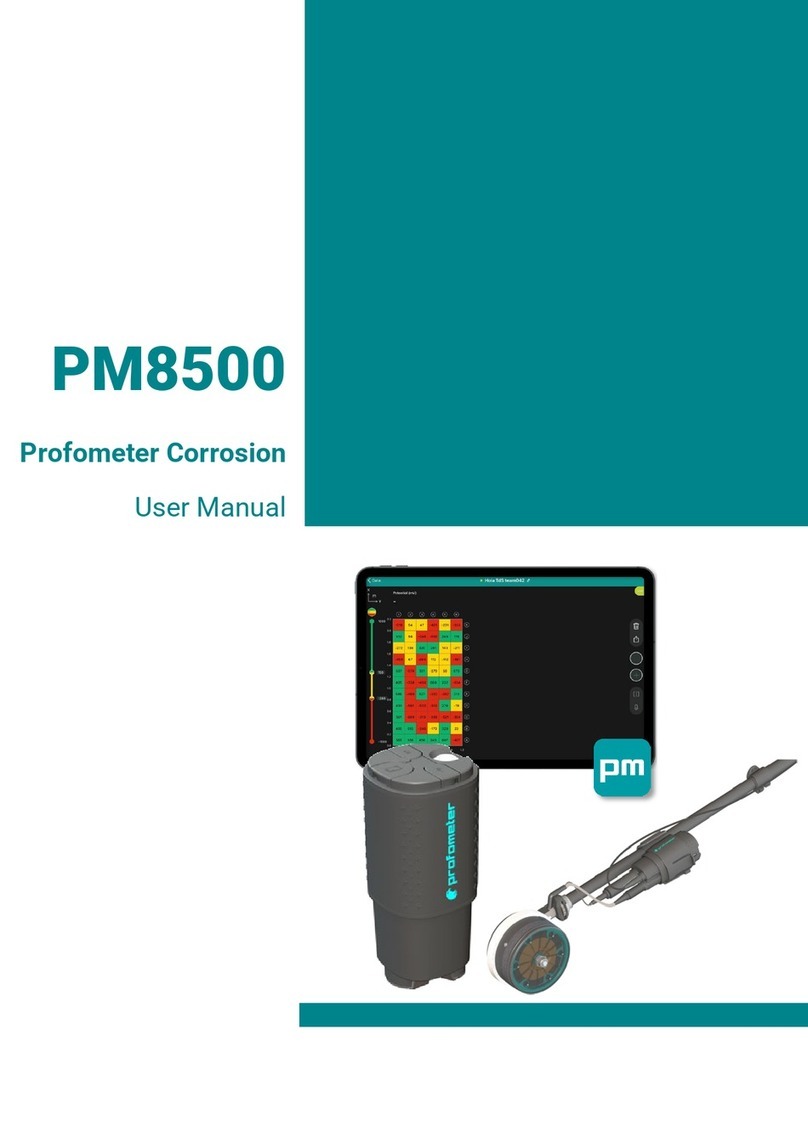
Proceq
Proceq PM8500 user manual

Coulometrix
Coulometrix Metiri COUMET60100SC user manual
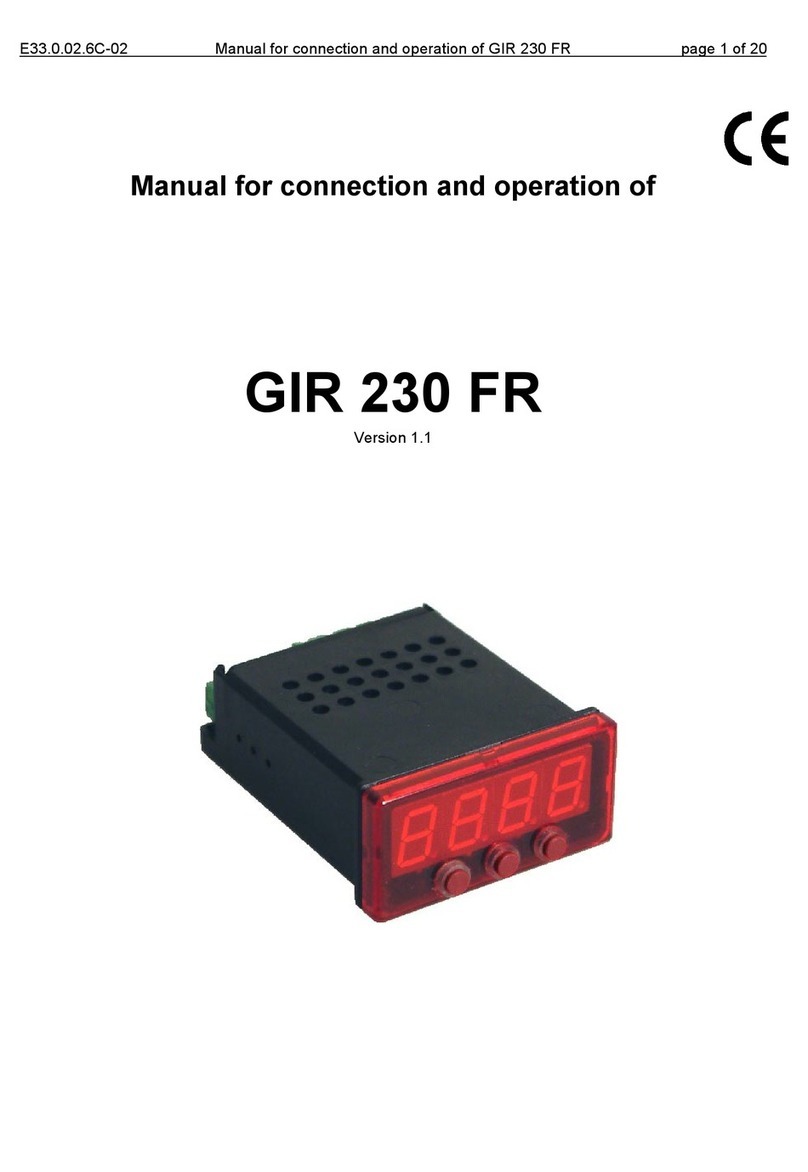
GREISINGER
GREISINGER GIR 230 FR manual
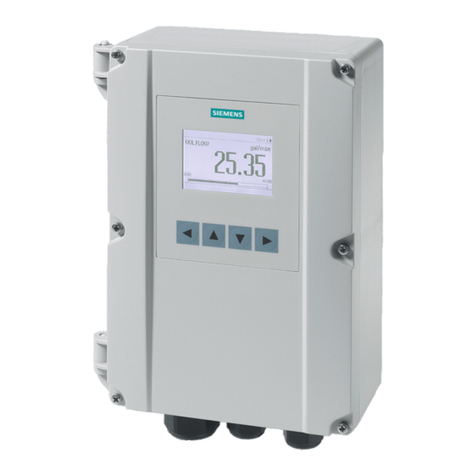
Siemens
Siemens SITRANS F operating instructions

Veeder-Root
Veeder-Root DIS-51 Installation, Setup & Operation Guide


